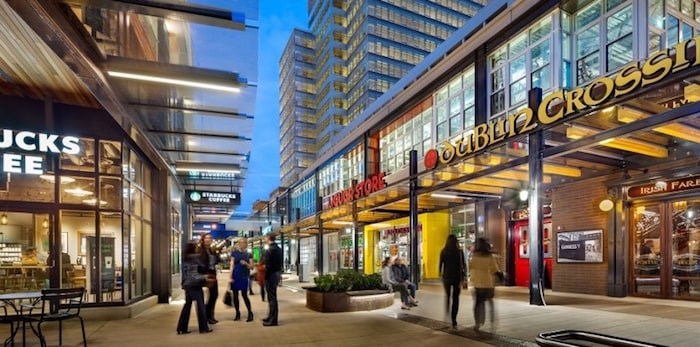 Marine Gateway by PCI Developments, whose VP of development Tim Grant was also on the panel, is a mixed-use project with retail, entertainment and residential, including public spaces that foster social interaction. Image via pci-group.com
Marine Gateway by PCI Developments, whose VP of development Tim Grant was also on the panel, is a mixed-use project with retail, entertainment and residential, including public spaces that foster social interaction. Image via pci-group.com
The days of office, industrial, retail, hotel and residential space being simply that â space â are gone, according to a panel of industry experts.
One of the hottest trends in North American real estate is âreal estate as a serviceâ (REaaS), a Â鶹´«Ã½Ó³»audience was told at the Urban Land Instituteâs November 26 launch of its 2020 Emerging Trends in Real Estate report, compiled by PwC.
Integral to this trend is putting tenant, customer and resident experience at the heart of real estate design.
This means commercial and residential real estate has evolved to offer customers and residents more than the space alone, adding on layers of experience and amenities that go beyond the physical floorplan.
In the office sector, this means work environments being ULIâs Emerging Trends report said, âBeyond good gyms, more tenants and their employees are looking for features such as proximity restaurants, and less tangible elements, such as a communal vibe.â
This âvibeâ can be designed into a development at initial concept stage, said panellist Sid Landolt, president and co-founder of real estate design and marketing firm S&P. âWe talk about creating community, but how do you land that plane? In the design of real estate, you must foster social interaction, through simply passing each other.â
Within residential real estate, this means moving away from having an underused common recreation room somewhere in a building, and instead designing in interior and exterior communal spaces that residents have to walk through on a daily basis. This creates natural interaction between neighbours that may not otherwise occur, said Landolt. âIn residential real estate, for years, weâve had amenities where you have to go into that amenity, experience it, and go out. Those are generally cold and quiet. Weâve been reading all these articles about loneliness in Â鶹´«Ã½Ó³»and in my mind, it comes from a lack of planning and poor design.â
ULIâs report noted that, taking this concept a stage further, cohousing is also on the rise in Canada. Developments in which families live in small, private units but share common spaces such as large kitchens, dining and recreational spaces, and participate in group activities and shared chores, have started popping up in some areas (one example in Vancouver ).
Flexibility for changing needs
Another key aspect of REaaS is the simple concept of renting space on an as-needed basis, rather than having a traditional fixed amount of space in a long-term lease or purchase. This trend has seen a massive upswing with the rise of co-working companies such as WeWork, and short-term rental of spaces for pop-up stores and restaurants.
Wendy Waters, vice-president of research services and strategy at GWL Realty Advisors, who was also on the panel, said, âWe think of the people who use our office space are our guests, and we try to provide a better experience for them. I think a lot of this switch to real estate as a service is a response to what consumers and businesses want, and what they need. You think about flexibility, the rise of co-working spaces and their huge success, and itâs because they offer space on a one-year lease, a three-month lease, whatever you need. And everythingâs ready to go, itâs turn-key. It offers the experience you want, itâs all right there, given to you as a service. Itâs not necessarily cheaper, but itâs simpler, and may offer better value in the long term.â
However, itâs not just office and retail space that could see a transformation from the temporary-use trend. ULIâs report noted that there is potential in the future for subscription-based housing programs, whereby people occupy different living environments based on their current needs and stage in life.
The report authors wrote, âMany people are focusing on monthly costs than total purchase price. While affordability is a factor, the REaaS trend also goes back to changing consumer behaviours as people look for more flexibility as their lifestyles and preferences evolve.â
Blurring property lines
Folding into all of this is the blurring of traditional boundaries between different types of real estate. Homes are now also hotels, with the rise of short-term rental platforms such as Airbnb. Retail spaces are increasingly becoming distribution hubs for products, with smaller retail footprints. Coffee shops, hotel conference rooms and homes are now also work spaces, with the rise of remote working due to technology. Restaurants and cafes offer retail elements, either for in-house branded products or in partnership with other brands. New residential developments offer retail and restaurant spaces at grade.
Panellist and keynote speaker Andrew Warren, PwCâs director of real estate research, said, âItâs all blurring. You used to be able to say, âI specialize in commercial real estate,â or âI specialize in industrial.â Now everybodyâs doing something in somebody elseâs space. The best example is retail and industrial, as e-commerce and online shopping are making distribution centres the new retail centres. Hotels are another, you used to have to rent a room in a hotel, now you rent a room in someoneâs house. Theyâre all blurring together.â
Landolt added that new-build residential is also seeing this blurring of property types. He said, âRetail and other services are now being embedded right into condo developments, whether thatâs a certain brand of bike-share or car-share as a service for the residents, whether itâs a branded fitness centre in the building, weâre now getting more and more brands engaging right at the home.â
Download the full Emerging Trends in Real Estate 2020Ìý°ù±ð±è´Ç°ù³ÙÌý.


